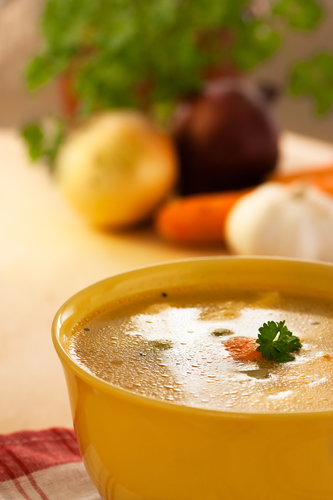Recipe: Healing Bone Broth


There are many variations for making bone broth and I share more about other delicious and time saving methods with participants in my classes and programs. In the recipe below, I share a simple version that you can make with either a whole organic chicken, or leftover bones from past chicken dinners. I recommend that you save the bones left over after your family eats the meat off the bones of any animal in a freezer baggie, labeled with the type of stock you want to make from it, in a designated area in your freezer just for these occasion of making homemade bone broth.
Bone broth assists our bodies in healing from chronic digestive disorders such as Irritable Bowel Syndrome (IBS), Crohn’s disease, ulcerative colitis, and other long term digestive issues. It’s simple and easy as most of the time spent making it is hands off time, while the pot slowly simmers on the stove top and the nourishing smell of chicken broth permeates the air. Bone broth is an essential ingredient in my kitchen and I hope it is or will be in yours too! If you choose not to make it yourself, you can always buy traditional bone broth from the great folks at Bare Bones Broth.
BONE BROTH RECIPE
Makes ~1+ gallons of finished broth, depending on how many parts and pieces you use and if you poach an entire chicken in your stock pot.
Ingredients:
- 1 organic whole chicken (~ 5 pounds), giblets removed and/or 3-4 lbs of bony chicken parts (necks, backs, breast bones and/or wings) saved from left over chicken bones from past chicken, turkey, or other poultry meals or whole packages of raw poultry parts. If you don't have a scale at home, this equals out to a few generous handfuls of bones, give or take. If you have plenty of room in your pot to cover with at least an inch of water over the top of your bones while still leaving yourself a headspace of an inch or two to prevent any liquid from bubbling over and making a mess of your stove, I encourage you to go for it. Note: Using raw and cooked parts will result in a stock that is less clear. Clear stocks are desirable
- 2 tablespoons vinegar (I prefer apple cider vinegar)
- 4 quarts filtered water (or more as needed to cover bones and chicken)
Optional, but tasty additions:
- 1 large onion, coarsely chopped
- 3 celery stalks, coarsely chopped
- 2 carrots, coarsely chopped
- 1-2 cloves garlic, smashed
- 1 bunch parsley
Directions:
- Place bones and all vegetables except parsley in a large stainless steel pot.
- Cover with filtered water and add 2 Tbsp vinegar. Let stand for 30 minutes to 1 hour. This acidic solution helps release the nutrients from the bones.
- Bring to a gentle rolling boil. Remove the scum that rises to the top with a large slotted spoon, and discard.
- Reduce heat, cover and simmer for 6 to 24 hrs. Keep in mind that the longer you cook the broth, the more savory and mineral-rich it will be! If you are looking for a reduced, more concentrated broth, be sure to simmer uncovered.
- 10-20 minutes before finishing, add parsley. This helps release additional mineral ions into the broth.
- Remove chicken pieces with a slotted spoon. Strain the broth carefully into a large bowl. If there is a lot of sediment in your broth, it can be helpful to first line the strainer with a thin cotton kitchen towel or cheesecloth.
- Place in the refrigerator until broth cools and fat rises to the top. This fat can be reserved for cooking purposes, especially if the broth was only cooked a few hours and if you do not have a sensitive digestive system. It is not advisable for folks with a more inflamed system to consume fat skimmed from broth that's been cooked for a long time. As always, be mindful of how your body feels and eat accordingly.
- Pour stock into glass jars. Store in the refrigerator for about one week or freeze for later use. Once the "fat cap" (the fat that seals the broth underneath it from air) is broken, consume the broth within five days.
Notes: For broth that is being frozen for later use, be sure and leave enough head space in the jar so that the expansion of the liquid will not cause the glass to break. Freezing the jars of broth on their side can help to avoid glass breakage. Freezing in plastic is not recommended because of leaching of various health disrupting toxins from the plastic into your life giving broth.
Enjoy in soups or sip a mug of this Gut Healing Broth in the morning. ENJOY!
Sources:
- Why Drinking Bone Broth is the Hot New Thing in Cuisine
- Bone broth has been featured in GQ magazine: What Is "Bone Broth" and Will It Give Me Super-Human Strength?!
- Bone broth has been named 2015's Food of the Year by Forbes Magazine and is lauded in Bon Appetit, The NY Times, and many famous chefs and nutritionists in 2015! I was interviewed about bone broth in Oregon Healthy Living earlier this year.

